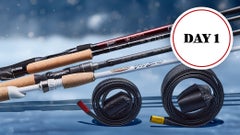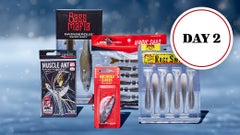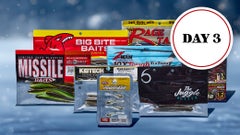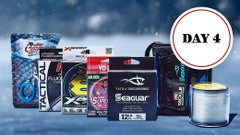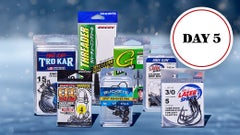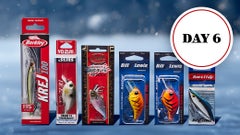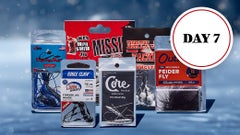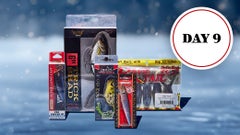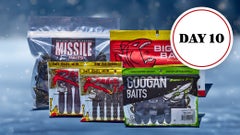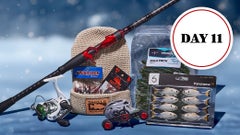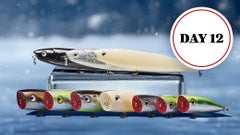BASS Falcon Lake Baits, Gear & Patterns
Keith Combs Wins BASS Falcon Lake
Competition:
Combs' day-1 bag was 4 pounds better than anyone else in the 100-angler field could manage, and he pushed his advantage to nearly 7 1/2 pounds the following day. He incurred a mechanical issue on day 3, however, which cut into his fishing time and forced him to spend the latter part of the day casting out of the boat of fellow competitor Clark Reehm. He picked up his fifth fish while aboard Reehm's vessel and he needed that one to stay in the top spot as Clunn came in with a tournament-best 36-14 stringer to take away all but a pound of his lead. The final round was postponed for a day due to winds that blew at a sustained 20 to 30 mph, with gusts up to 45. The postponement undoubtedly benefited him much more than Clunn, as the latter was working a partially protected area near the launch site and likely could've caught another big bag in spite of the conditions. When the Top 12 finally got back on the water on Monday, Combs had an early flurry and surpassed the 20-pound mark by about 9:30. He caught the fish that may have put him over the top - a 7 1/2-pounder - with just 10 minutes remaining in the day.
Winning Pattern:
One area near the dam at the south end of the lake produced nine of the fish that Combs took to the stage. The other 11 came from various places that were scattered all over the venue. "I had a milk run of about 15 spots that were all similar - underwater ledges with rock that quickly dropped off into 6 to 10 feet," he said. "Most of them were 5 to 8 miles apart." The dam area produced three weigh-in fish on day 1, none on day 2, two on day 3 and four on day 4. "The first and the third day I caught them off the exact same spot, but where I caught them (on day 4) was about a half-mile away on another ledge. The area hadn't been real consistent (during the winter) because of the low flow of water coming through. In my opinion, what makes that area good is when they're pulling water, the fish gravitate toward it. "When they're not pulling water, it scatters them out. Some might be on top, some might be suspended and some might be out deep, and you can't pattern them." His Humminbird electronics units with the Side Imaging feature played a huge role. He didn't look for fish, but rather the cover on which they were holding. "I very seldom look for fish on the graph at Falcon because there's so many species that you really don't know what you're looking at. The tilapia and the catfish are thick in that place. "I just look for the features and fish them. It can be too hard to interpret exactly what's there. Sometimes (the bass) are on isolated rockpiles, but this time they were on the ledges and there might be only one corner that has the right vertical break, and sometimes it might be on the shallower side of the point." Seventeen of his weigh-in fish bit a Strike King 6XD crankbait. Two fell for a big worm and the other was enticed by a creature bait on a Carolina rig. "Most of the time I was burning the crankbait as hard as I could. I think that was the key - it was a reaction deal."
Winning Gear:
Cranking gear: 7' medium-action fiberglass Power Tackle PGC170 rod, Shimano Chronarch casting reel (7.3:1 ratio), 15-pound Seaguar Tatsu fluorocarbon line, Strike King 6XD (chartreuse with powder-blue back). The creature bait for his Carolina rig was a Strike King Rage Hawg (green-pumpkin). His worm was an unnamed 10-incher (plum).
Main factor: "It was definitely spending lots and lots of time and gaining experience out there."
Performance edge: "My two Humminbird 1198s with Side Imaging, for sure. Without them, I would've just been kind of throwing my bait out there."
Falcon Lake Elite Series Winning Pattern Bassfan 3/27/13 (John Johnson)
Rick Clunn's Pattern, Baits & Gear
Cranking gear: 7' medium-action fiberglass Wright & McGill Rick Clunn Signature Series rod, inshore saltwater reel (6.2:1 ratio), 17-pound XL monofilament line, Luck-E-Strike Series Series 3 crankbait (copper green shad). "That's a bream color and it's good anytime around the spawn," he said of the bait. "Fish that are spawning hate bream." He replaced the stock hooks on his square-bill with 1/0 extra-strong Eagle Claw trebles to prevent bending while wrestling with giant fish in brush. "I would've used a TroKar, but they don't make a hook like that yet," he said. The larger bait that produced his first two fish of the tournament and with which he found his primary area during practice was a Luck-E-Strike Freak. He said he pulled off his fish when he had 34 pounds and some change on day 3 and began working some perimeter stuff with a jig and shaking off the bites. One fish wouldn't come unstuck - an 8-plus-pounder that resulted in a 2-pound cull.
Main factor: "Having that spot to myself and being able to make those transitions along with the fish."
Performance edge: "That glass rod is just a miracle rod for that type of fishing - it does things no other rod can do. It just hooks the fish and fights them so well. Also the Power-Poles because I could move here and move and stop and pick the place apart. I'd have won at least six more events if I'd had them my whole career. You can do so much more fishing."
Falcon Patterns 2-5 Bassfan 3/27/13 (John Johnson)
John Crew's Pattern, Baits & Gear
Cranking gear: 7'8" medium-heavy Pinnacle Perfecta cranking rod, Pinnacle Optimus LTE casting reel (7.3:1 ratio), 12-pound Vicious Pro Elite fluorocarbon line, Spro Little John DD (root beer/chartreuse).
Flipping gear: 7'6" medium-heavy Pinnacle Perfecta flipping stick, same reel (7.3:1 ratio), 25-pound Vicious Pro Elite fluorocarbon, 1/4- or 5/16-ounce unnamed tungsten weight, 3/0 Gamakatsu Heavy Cover worm hook, Missile Baits Missile Craw (green-pumpkin/red or superbug). He flipped the green-pumpkin/red bait under bright skies and superbug when the sun was obscured by clouds. He caught two weigh-in fish on a Missile Baits Tomahawk worm (melon cinnamon purple).
Main factor: "Figuring out on the first day that they were really eating the Missile Craw. I didn't need to go around and shake off a hundred fish."
Performance edge: "I'd have to say my Bass Cat boat. (On day 4) I had all the confidence in the world to fly 20 miles down the lake and then all the way back in the last hour and 45 minutes."
Falcon Patterns 2-5 Bassfan 3/27/13 (John Johnson)
Josh Bertrand's Pattern, Baits & Gear
Cranking gear: 7'9" medium-action Temple Fork Outfitters Tactical Series rod, Abu Garcia Revo Winch casting reel (5.4:1 ratio), 12-pound Berkley Trilene 100% fluorocarbon line, Spro Little John DD (citrus shad).
Carolina rig gear: 7'3" Temple Fork Outfitters Tactical Series rod, Abu Garcia Revo STX casting reel (7:1 ratio), 20-pound Berkley Trilene 100% fluorocarbon (main line and 2' leader), 1-ounce XPS tungsten weigh, red tungsten bead, barrel swivel, 6/0 Gamakatsu SuperLine EWG hook, 7" Yamamoto Senko (green-pumpkin/purple/green) or 10" Berkley Power Worm (plum).
Main factor: "Sticking to that one area."
Performance edge: "We had some rough water on a couple of days and my Nitro/Mercury got me there and back. My Navionics chip was real important, too."
Falcon Patterns 2-5 Bassfan 3/27/13 (John Johnson)
Cliff Prince's Pattern, Baits & Gear
Flipping gear: 7'8" extra-heavy Duckett Fishing White Ice Terry Scroggins Signature Series rod, Lew's Tournament Pro casting reel (6.3:1 ratio), 60-pound Seaguar Kanzen braided or 25-pound Seaguar InvizX fluorocarbon line, 1/2-ounce unnamed tungsten weight, 5/0 Owner Straight Shank Wide Gap hook, Yum Wooly Bug or Yum Vibra King tube (green-pumpkin).
Cranking gear: 7'3" medium-action Duckett Fishing White Ice cranking rod, same reel, 12-pound Seaguar InvizX fluorocarbon line, Bomber Fat Free Shad (sexy shad).
Spinnerbait gear: 7'1" medium-action Duckett Fishing White Ice rod, same reel, 17-pound Seaguar Senshi monofilament line, 1/2-ounce Booyah double willow-leaf spinnerbait (white/chartreuse).
Main factor: "Just keeping a positive attitude about what I was doing and getting some really good bites every day. I made good decisions and I had some idea what it would take to get bit."
Performance edge: "I used good line. I didn't have any issues with breaking fish off and I think that was because of the line I was using."
Falcon Patterns 2-5 Bassfan 3/27/13 (John Johnson)














